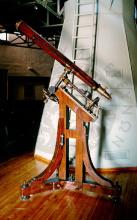Technical description:
Refracting telescope.
Mounting : German equatorial (steel axis).
Lens : Fraunhofer type Achromatic doublet 158mm.
Focal ratio : f/15.
History:
This is one of the most monumental instruments of the Observatory, excellent for planetary observations. Julius Schmidt used this telescope to perform the necessary observations that led to his charting the best part of the famous Map of the Moon.
It was acquired with funds by George Sinas and is among the instruments brought from Vienna by Georgios Vouris, in September 1847. It had been the biggest telescope of the Observatory until 1901.
When acquired, it constituted a mid-size telescope of its era. From 1838 and up until 1866, the Merz-Mahler telescope at the Pulkovo observatory (Russia) was the largest refractor telescope, 380mm in diameter. Using a similar but even larger telescope (manufactured by Fraunhofer, D=240mm, f=430cm) F.V. Struwe managed to measure the parallax of fixed stars at the Dorpat observatory in Estonia.
The base of the telescope extends to the foundations of the building in order to avoid unwanted vibrations. The dome was constructed with copper plates on a steel framework and was driven over a 360ο angle by a manual movement device. This combined with an opening gate, allowed observation to all parts of the sky.
The instrument was used for solar Ha observations during the period 1955-1970. It was the main astronomical instrument of the National Observatory of Athens in its early period (1845-1902).
Fraunhofer - type achromatic lens:
Early refracting telescopes comprised of a single objective lens, the result being that due to this refraction, individual wavelengths (colours) could not focus on the same point.
Opticians attempted to make up for this error by using two or more objective lenses of varying shapes and materials, so that the optical error would be cancelled out due to the different angles of refraction.
Fraunhofer's twin objective lens comprises a plano - concave lens of crown glass and a concave lens of flint glass whose curvatures are varying, so that they are not in contact with each other. This method allowed Fraunhofer to achieve a substantial reduction of the colour error of telescopes.

